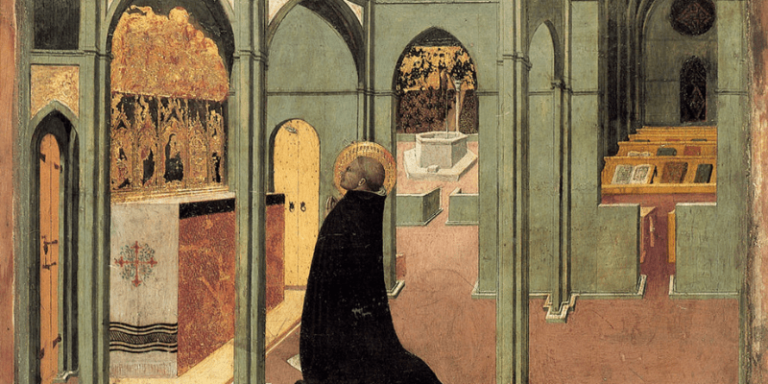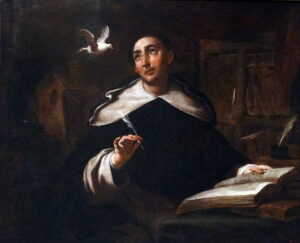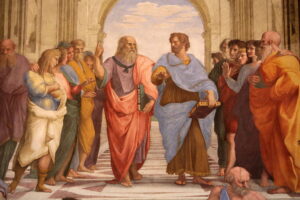Thomas Aquinas: Father of the Renaissance?
Without Aquinas, it’s unlikely the Renaissance could have happened.
By: Caroline Adana | June 12, 2021 | 815 Words

Saint Thomas Aquinas in Prayer (Photo by Fine Art Images/Heritage Images/Getty Images)
During the Medieval Warm Period, St. Thomas Aquinas (1225-1274) reintroduced the ancient Greek philosopher Aristotle into Europe after his ideas had been lost for centuries.
Who Was Thomas Aquinas?
Thomas Aquinas was an Italian who belonged to the Dominican order of the Catholic Church. He was born to a modestly wealthy family, and at the age of five he was sent to live in a monastery.

Painting depicting Saint Thomas Aquinas by Antoni Viladomat (Photo by Universal History Archive/Universal Images Group via Getty Images)
When he was 14 years old, he was sent to the University of Naples. He excelled at his studies, but has a rather non-traditional view of faith and the church. He secretly joined the Dominican order, despite his family’s objections. His parents had hoped he would become an influential figure in the church, but Aquinas chose to devote himself of the realm of ideas and a new approach to Christianity based on reason. He was ordained as a priest in Germany in 1250. he traveled far, preaching and writing on his journeys. He also taught theology at the University of Paris.
In 1273, he suddenly stopped writing and teaching after reportedly experiencing a disturbing vision. After his death in 1274, many of his works were condemned by the church. However, years later, he was acknowledged as a major influence on the development of the church, and was eventually canonized as a saint in 1323.
St. Augustine and Plato
To understand the importance of Thomas Aquinas, we have to retrace our steps to another essential Christian thinker, namely St. Augustine (A.D. 354-430). St. Augustine played a major role in shaping European Christian thought after the fall of Rome, and he had been deeply influenced by Aristotle’s teacher, Plato.
Plato believed that ideas are perfect objects that live in “the region above the heaven” or the “hyper-heaven.” He argued that the physical world humans live in is just an imperfect shadow of those ideas. Therefore, Plato saw our world as an illusion and the world of ideas as real. He had a mystical point of view, suggesting that a few devoted people could access the world of perfect ideas through spiritual revelation.
St. Augustine saw certain similarities with Plato’s philosophy and the Christian doctrine, and his theology became popular during the Dark Ages, otherwise known as the early Middle Ages. Some people believe that the stagnation during this period is due to the influence of Plato.

Detail from ‘The School of Athens’ by Raphael. Depicting Plato and Aristotle in discussion. (Photo by: Godong/Universal Images Group via Getty Images)
Aristotle
Perhaps Aquinas’ chief achievement was the reintroduction of Aristotle into Europe.
Although Aristotle was Plato’s student, he rejected almost everything his teacher stood for. He, too, believed in ideas but thought they were part of our physical world and that everyone could access them through reason and logic.
One of Aristotle’s lasting ideas was his concept of eudaimonia, which translates literally to “good spirit.” Today, we instead use the word “happiness.” Aristotle’s ethics were all about achieving eudaimonia – happiness.
But he did not mean pleasure-seeking or “having fun.” Instead, he intended people to build good moral habits so that they would become the best possible version of themselves. Then, if people perfected themselves, they would be rewarded with the self-esteem of moral accomplishment – happiness.
Through Aquinas, Aristotle’s ideas helped begin the Renaissance and the Enlightenment movements that came about in Europe over the next few centuries. For example, Thomas Jefferson wrote in the United States Declaration of Independence the Aristotelian idea that “all men are created equal, that they are endowed by their Creator with certain unalienable Rights, that among these are Life, Liberty and the pursuit of Happiness.”
Faith and Reason
Aquinas brought back the love of reason into Europe. Under Augustine, reason was believed to be useless, since one could not understand God’s creation. By contrast, Aquinas thought that God had shone the light of faith and reason into the hearts and minds of humans. Thus, humanity is endowed with faith to have communion with God, as well as reason to understand God’s creation.
Even today, nearly 800 years later, the harmony of faith and reason is a pillar of the Catholic Church.
The Renaissance
The work of Aquinas popularized Aristotle across Europe and changed Christianity forever. It started a period of renewed optimism and belief in the ability of humans to understand the world through reason.
It was also a period when classical Roman and Greek art was rediscovered and reintroduced in Europe. It has later become known as the Renaissance, which is French and translates to “rebirth.”
Although other important people contributed to the Renaissance, it is hard to imagine it could have happened without Thomas Aquinas.
















